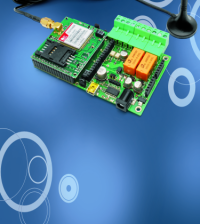- makeITcircular 2024 content launched – Part of Maker Faire Rome 2024Posted 2 weeks ago
- Application For Maker Faire Rome 2024: Deadline June 20thPosted 2 months ago
- Building a 3D Digital Clock with ArduinoPosted 7 months ago
- Creating a controller for Minecraft with realistic body movements using ArduinoPosted 7 months ago
- Snowflake with ArduinoPosted 8 months ago
- Holographic Christmas TreePosted 8 months ago
- Segstick: Build Your Own Self-Balancing Vehicle in Just 2 Days with ArduinoPosted 8 months ago
- ZSWatch: An Open-Source Smartwatch Project Based on the Zephyr Operating SystemPosted 9 months ago
- What is IoT and which devices to usePosted 9 months ago
- Maker Faire Rome Unveils Thrilling “Padel Smash Future” Pavilion for Sports EnthusiastsPosted 10 months ago
GSM Remote Control – Part 1
Introduction
A modular solution allowing for the use of a single circuit for numerous functions, such as gate opening, bidirectional telecontrol, and many others. It adopts a newly-conceived low-cost GSM/GPRS module.
Nowadays, creating a remote control is much simpler and safer than it used to be, even if it is to be used from the other side of the world; what made this possible was the advent of cell phones and the availability of low-cost GSM/GPRS modules that could be easily integrated in stand-alone solutions, capable of handling both calls and SMSs. The use of SMSs allows one to know the exact output of the commands that have been given, since it is enough to set sent messages to confirm a relay commutation in order to be sure that a given command was properly executed. Precisely because of the possibilities offered by a cell-phone based remote control, and encouraged by popular demand, in the past few years, we have developed several solutions capable of performing functions related to telecontrolling, telereading, gate opening, remote thermostat, and more. Having done all of that, we asked ourselves what else we could do for you. Well, we finally thought of something that could condense in a single printed circuit (as big as all the other devices we had previously proposed) the hardware needed to implement all the possible functions, such as those related to the remote control, the gate opener, and so on and so forth. We were able to achieve all of this by simply creating a system in which the relevant elements had been divided into two distinct sections: a small board basically including the GSM/GPRS module and another small board including the managing microcontroller, entrances, exits, and a few other things. Such a modular structure allows users to customize the second small board by simply adding (or failing to add) given components; add to this the fact that, depending on the desired functions, you can install different types of firmware in the microcontroller. But we didn’t think this was enough: as I said, in order to make the system even more versatile, we decided to have a specific small board host the GSM module, which, in previous circuits, was mounted on the printed board through a special connector; the small board hosting the GSM module in our new device can be inserted in the basic printed board through a standard SIL Connection at a pitch of 0.10 inches. This means that, if the GSM module should stop working and should no longer be available on the market (which is not a far-fetched possibility given that the section of the market dealing with individual components is full of models that come and go…), users can replace it with a different module, by simply replacing the interface card, whose connections are, after all, always the same: serial channel of data communication, communication control signals, and power supply. The GSM module antenna is directly connected on the supporting small board so as to avoid coupling problems that might occur if the corresponding connection were to go through the pin-strips required for assembling components on the basic printed board. Moreover, in order to further facilitate the search for a new model of the GSM module, we designed the supporting small base, as well as its interface, in such a way that two additional modules can be mounted: SIM900 by SIMCom or M10 by Quectel. In short, we couldn’t have delivered anything better! Besides, these two modules are among the most inexpensive on the market, so, compared to previous devices, this new remote control will definitely cost you less.
Block Diagram
Given the above premises, let us now turn to the hardware; in the next issues, we will be describing the applications that can be developed, namely, a gate opener with relay output, a remote control with two relay outputs and two opto-isolated inputs, a GSM thermostat with a temperature sensor, auxiliary input, and relay output, and finally a remote control with two opto-isolated inputs, two relay outputs, and the option to receive commands in DTMF.
Gate Control
Temperature Control
2 IN – 2 OUT
2 IN – 2 OUT with DTMF Control





















One Comment